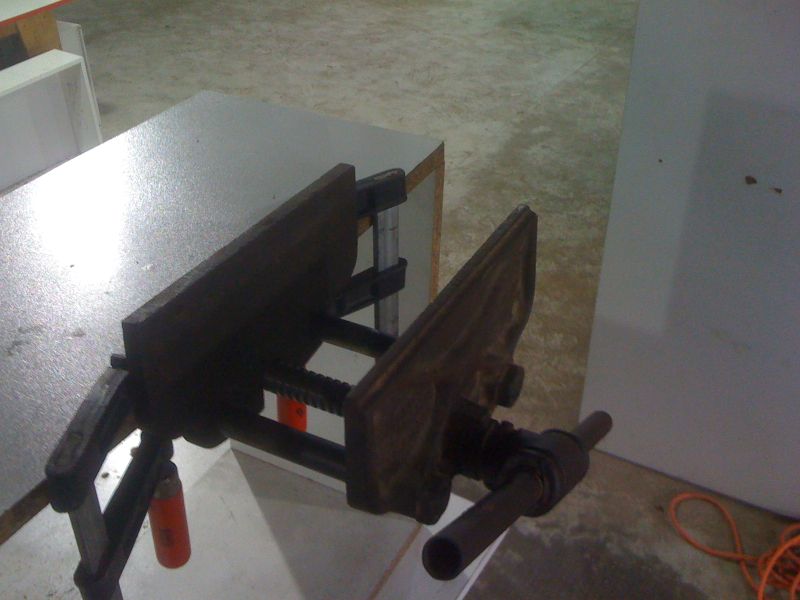Cabinet Doors Tips and Tricks
A start-up cabinet door manufacturer gets some advice on production methods. October 2, 2007
Question
I have just established a cabinet door production facility and have completed my first order of 50 doors. The tools that I used were table saw, Triton router, Dewalt planer, orbital sander, jet parallel clamps, and a lot of hand sanding. I was wondering if I made my stiles and rails wider than desired width. Is there a machine or tool apart from the table saw that can be used to trim to final size? Would a radial arm saw be appropriate?
Forum Responses
(Cabinetmaking Forum)
From contributor J:
Large door manufacturers use double-end tenoners to size doors. For smaller operations, consider over-sizing your doors by 1/8". For example, if your rail/stile stock is 2 1/2" finished, begin with 2 5/8" stock. That way, as the stock moves from rough stock to finished, you end up with 2 1/2" or whatever your finished sizes are. One suggestion, though. If you are going to make a lot of doors, get away from the parallel clamps and get an automatic door clamp. Much faster and you can assemble and pin a door in less than 2 minutes. Also, squaring the door is simplified. Just because you put bessys or jets on a door, doesn't make it square.
From contributor J:
Oh, almost forgot. Voorwood makes a machine that will raise panels and edge doors. The door profiler removes 1/16" per pass, so you would need to oversize your doors by 1/8". That way, when you put your edge profile on, the doors come out the proper size. But this opens a whole other can of worms. For instance, now you are using one machine to accomplish two tasks, which means that as you grow, you will have a bottleneck there. If possible, structure your shop so that you have dedicated machines that perform one task well. It will help eliminate bottlenecks.
From the original questioner:
Thanks for your recommendations and methods for sizing doors. I am looking at replacing the jet clamps with the JLT door clamp, but this will be done when I can afford it. I am experiencing a few doors not being totally squared, but I find when I don't apply too much clamp pressure on the clamps that run in line with the stile, the result is a perfect squared door.
From contributor J:
Are you pinning your doors? That would free up your clamps. What I mean is that after you glue and clamp your doors, shoot a couple of pins (I use a 23 gauge pinner) into the joints. Doesn't hurt to shoot a pin at the top and bottom center of the panel groove to hold the panel steady, too. That way, you can remove the door from the clamp and take it to the next processing station. In our operation, as soon as the doors come off the JLT clamp, we send them through the widebelt to flatten them. Again, good luck!
From the original questioner:
I really appreciate you taking the time to offer your expertise and guidance on building cabinet doors. Incidentally, I am in the process of securing the SENCO kit PC0947 which was recommended by SENCO. This pinner uses 18 gauge pins, and minimum length of pin that it uses is 5/8". Is this okay? I noticed you mentioned you use 23 gauge. At the moment I hold the doors in the clamps for an hour using Titebond Original. Finished thickness is 3/4".
From contributor R:
I rip my stiles and rails 2 3/8'' then add 1/4'' to the length of my stiles, then take off 1/8th on all 4 sides. Table saw for ripping down to width, then a radial arm saw that crosscuts 25'' to cut to height. My doors are square, so this trimming to size is a time consuming precaution that probably is not worth the time, but it's better to be safe than sorry. Space balls are another time thief when it comes to assembly. 3/8'' long brads are needed. Brad them to hold in place. Makes it much faster, then let the clamp override the brads. I don't think brads hold the joint tight enough, but many shops just clamp them, then brad nail, and then unclamp.
From contributor J:
5/8" will work for the joints, but will probably go through the profile if you pin the panels. Also, 18 gauge brads leave a hole big enough to need putty. I use the 23 gauge with 1/2" pins. No need to putty and the 1/2" size works for the joints and the panel. Contributor R's methods work well too. Just remember the purpose of the pins is to hold the joints steady while the glue sets up. There are many different ways to get to the same place. That is why cabinetmaking is so much fun.
From the original questioner:
Okay, contributor R, I'll try your method, but I don't have the radial arm saw, so will probably have to make a sled for the table saw, and hope I can get a perfect 90 degree cut. Where I am located, space balls are not an issue, as movement of the wood is somewhat limited in the tropics as compared to North America. I'll stick with the 18 gauge pinner and see how that goes, as I will only be pinning the joints so that I can remove from the clamps to keep production up. Thanks again for your input, and happy woodworking.
